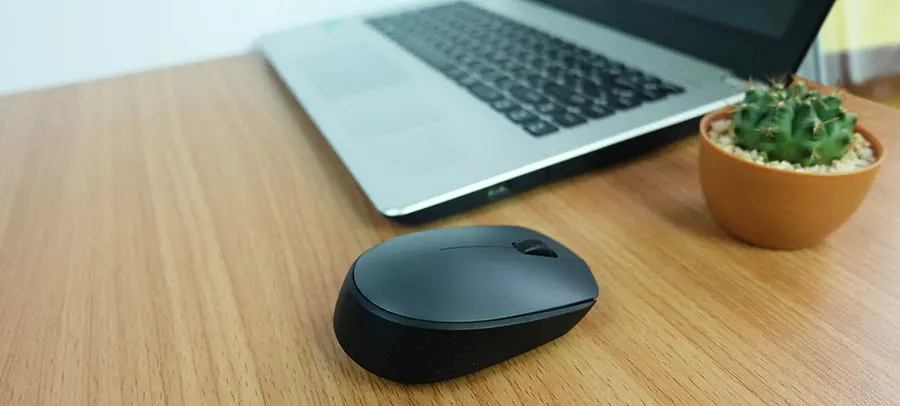Touchscreen laptops are great to use in dim lighting. However, the glossy touchscreen doesn’t always respond as fast as an external mouse. If you’re only relaxing and browsing the internet, speed usually isn’t a problem. However, if you’re multitasking for work you don’t have time for the touchscreen to catch up, you might be wondering if you can use a mouse with a touch-screen laptop?
You can use a mouse with a touchscreen laptop either through a USB cable or maybe Bluetooth. Most Windows laptops also let you turn the “touch” function off so you can use a mouse, although you may not want to do this for a couple of reasons.
There are times when the touchpad will come in handy, so you don’t want to completely get rid of the feature. Either way, here’s what you need to know about using an external mouse with a touchscreen laptop or tablet (our guide).
What Touchscreens on Laptops are For
There are some Windows computers with touchscreens, like the Microsoft Surface (on Amazon), which is designed for easier use in tablet mode. This means that when you’re using the touchscreen functionality the laptop operates more efficiently. In other words, turning off the “touch” function may not be the decision you want to make, although, it may seem like a good idea at the time.
When You Want Touchscreen Functionality
A touchscreen is convenient when scrolling through content because it’s faster than using a mouse. The stylus that comes with the touchscreen is also ideal for drawing. Your limited in what you can create unless you’re a pro with a mouse. It’s also easier to navigate a tablet’s menu options with the touchscreen. Touchscreens tablets and laptops are also easily portable.
If you’re working in an area where space is limited, not having to use a mouse is often more convenient. There are times when using the touchscreen is the best option, but all laptops with this function also allow you to turn it off. So, regardless of the make and model, you can use a mouse with any touchscreen-enabled device.
Using a Mouse vs. Using the Laptop’s Touchpad

Your laptop probably came with a mouse/touchpad built-in and it’s accessible when the laptop is open and functions as a mouse. While it is effective, the touchpad also has a slower response than an external mouse, so if you’re a laptop user, you won’t want the delay. Some touchscreen tablet-style laptops actually don’t come with a touchpad mouse at all.
Your only option is to connect an external one unless you don’t mind being limited to the touchscreen. Connecting an external mouse is simple. Some connect via a USB plug and others pair with your laptop via Bluetooth. One great, highly-reviewed option is the MX Master To-Go Mouse (on Amazon). The wireless mouse can pair with up to three devices and easily switch back and forth between them. This way, you only need one external mouse for your laptop, PC, and tablet.
How to Turn the Touchscreen Off
When you need to turn the touchscreen function off, instructions differ for tablets and laptops. Most tablets limit user access to and control of the device’s operating system. You might find that the only way to turn it off is to contact the manufacturer for specific instructions. Your best bet is to just go poke around in the settings and do some googling on your specific hardware.
How to Disable Touchscreen on Laptops
It’s a little easier to disable the touchscreen feature on laptops. To turn it back on, simply reverse the steps. Here’s what you need to do to turn the touchscreen off on your laptop.
- If you have Windows 10, press Windows + X on the keyboard. This will give you access to the Power User menu.
- In the menu click on “device manager”. You’ll see an arrow next to Human Interface Devices, on the left. Click on the arrow.
- You should have an expanded list of controls and devices. Look for “HID-compliant touch screen” and right-click on it.
- A popup will appear asking if you want to disable the function. Click on the option marked “disable”.
- Select “yes” when the warning box appears, and you’ll know that the function is disabled when a small downward arrow icon appears next to the menu listing for “HD-compliant touch screen.” It’s also obvious when the screen doesn’t respond to your touch.
Conclusion
There are times when having touchscreen functionality is convenient. Touchscreen laptops and tablets are great for use in smaller spaces that don’t always have room for a mouse and it’s also easier to draw and quickly scroll through content with a touchscreen. Regardless of how convenient touchscreen functionality is, there are times when you need an external mouse.
It’s not hard to disable the touchscreen and connect a mouse, though tablets are a little more complicated than laptops. When you need touchscreen functionality, it’s just as easy to turn it back on, in other words, it’s not a terrible idea to have an external mouse on hand because it’s easy to disconnect and connect whenever you want.
